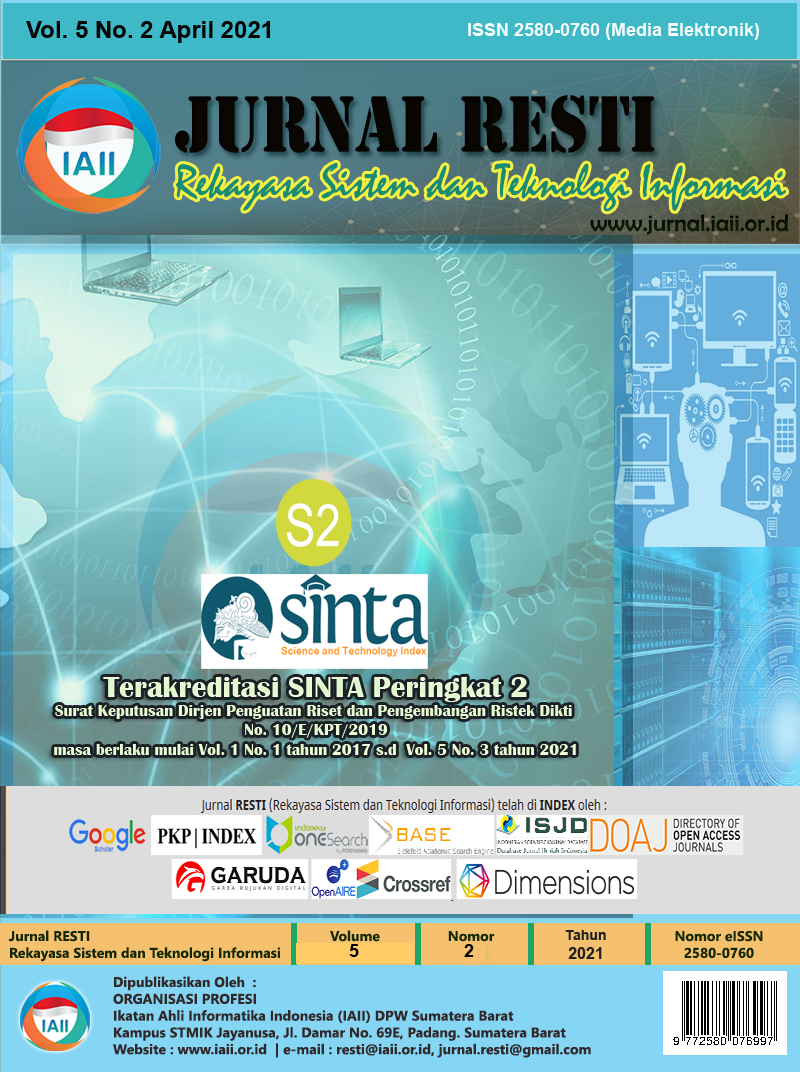Penerapan Deep Learning dalam Deteksi Penipuan Transaksi Keuangan Secara Elektronik
Abstract
The rapid development of information technology coupled with an increase in public activity in electronic financial transactions has provided convenience but has been accompanied by the occurrence of fraudulent financial transactions. The purpose of this research is how to find the best model to be implemented in the banking payment system in detecting fraudulent electronic financial transactions so as to prevent losses for customers and banks. Fraud detection uses machine learning with ensemble and deep learning with SMOTE. Financial transaction data is taken from bank payment simulations built with the concept of Multi Agent-Based Simulation (MABS) by banks in Spain. To build the best model, not only pay attention to the accuracy value, but the value of precision is a value that needs attention. A precision score is very important for fraud prevention. Fraud detection gets the best results without the SMOTE process by using deep learning with an accuracy score of 99.602% and precision score of 90.574%. By adding SMOTE, it will increase the accuracy score and precision score with the best model produced in the Extra Trees Classification with an accuracy score of 99.835% and precision score of 99.786%.
Downloads
References
H. M. M. H. Vidanelage, T. Tasnavijitvong, P. Suwimonsatein and P. Meesad, "Study on Machine Learning Techniques with Conventional Tools for Payment Fraud Detection", 2019 11th International Conference on Information Technology and Electrical Engineering (ICITEE), Pattaya, Thailand, pp. 1-5, 2019.
J. Yao, J. Zhang and L. Wang, "A financial statement fraud detection model based on hybrid data mining methods", 2018 International Conference on Artificial Intelligence and Big Data (ICAIBD), Chengdu, China, pp. 57-61, 2018.
D. S. Sisodia, N. K. Reddy and S. Bhandari, "Performance evaluation of class balancing techniques for credit card fraud detection", 2017 IEEE International Conference on Power, Control, Signals and Instrumentation Engineering (ICPCSI), Chennai, India, pp. 2747-2752, 2017.
L. Abhishek, "Optical Character Recognition using Ensemble of SVM, MLP and Extra Trees Classifier", 2020 International Conference for Emerging Technology (INCET), Belgaum, India, pp. 1-4, 2020.
L. Zhang, J. Xiong, H. Zhao, H. Hong, X. Zhu and C. Li, "Sleep stages classification by CW Doppler radar using bagged trees algorithm", 2017 IEEE Radar Conference (RadarConf), Seattle, WA, USA, pp. 0788-0791, 2017.
L. N. Eeti and K. M. Buddhiraju, "Comparison of AdaBoost.M2 and perspective based model ensemble in multispectral image classification", 2017 IEEE International Geoscience and Remote Sensing Symposium (IGARSS), Fort Worth, TX, pp. 3684-3687, 2017.
H. Ding, G. Li, X. Dong and Y. Lin, "Prediction of Pillar Stability for Underground Mines Using the Stochastic Gradient Boosting Technique", in IEEE Access, vol. 6, pp. 69253-69264, 2018.
H. Luo, X. Pan, Q. Wang, S. Ye and Y. Qian, "Logistic Regression and Random Forest for Effective Imbalanced Classification", 2019 IEEE 43rd Annual Computer Software and Applications Conference (COMPSAC), Milwaukee, WI, USA, pp. 916-917, 2019.
Aries Saifudin, Romi Satria Wahono, “Pendekatan Level Data untuk Menangani Ketidakseimbangan Kelas pada Prediksi Cacat Software”, Journal of Software Engineering, Vol. 1, No. 2, Dec. 2015.
Herlambang, MB. Deep Learning. [Online] Available: https://www.megabagus.id/artificial-intelligence/, Accessed Jan.01, 2021.
Wang, L. and C. Wu, “Business failure prediction based on two-stage selective ensemble with manifold learning algorithm and kernel- based fuzzy self-organizing map”, Knowledge-Based Systems. 121: p. 99-110, 2017.
Ching-Chiang Yeh, Der-Jang Chi, Tzu-Yu Lin & Sheng-Hsiung Chiu, “A Hybrid Detecting Fraudulent Financial Statements Model Using Rough Set Theory and Support Vector Machines”, Cybernetics and Systems, 47:4, 261-276, 2016.
A. K. Rai and R. K. Dwivedi, "Fraud Detection in Credit Card Data using Unsupervised Machine Learning Based Scheme", 2020 International Conference on Electronics and Sustainable Communication Systems (ICESC), Coimbatore, India, pp. 421-426, 2020.
H. Najadat, O. Altiti, A. A. Aqouleh and M. Younes, "Credit Card Fraud Detection Based on Machine and Deep Learning," 2020 11th International Conference on Information and Communication Systems (ICICS), Irbid, Jordan, pp. 204-208, 2020.
S. C. Dubey, K. S. Mundhe and A. A. Kadam, "Credit Card Fraud Detection using Artificial Neural Network and BackPropagation," 2020 4th International Conference on Intelligent Computing and Control Systems (ICICCS), Madurai, India, pp. 268-273, 2020.
S. Xuan, G. Liu, Z. Li, L. Zheng, S. Wang and C. Jiang, "Random forest for credit card fraud detection," 2018 IEEE 15th International Conference on Networking, Sensing and Control (ICNSC), Zhuhai, China, pp. 1-6, 2018.
V. Jain, M. Agrawal and A. Kumar, "Performance Analysis of Machine Learning Algorithms in Credit Cards Fraud Detection," 2020 8th International Conference on Reliability, Infocom Technologies and Optimization (Trends and Future Directions) (ICRITO), Noida, India, pp. 86-88, 2020.
X. Yu, X. Li, Y. Dong and R. Zheng, "A Deep Neural Network Algorithm for Detecting Credit Card Fraud," 2020 International Conference on Big Data, Artificial Intelligence and Internet of Things Engineering (ICBAIE), Fuzhou, China, , pp. 181-183, 2020.
G. Castaneda, P. Morris and T. M. Khoshgoftaar, "Maxout Neural Network for Big Data Medical Fraud Detection," 2019 IEEE Fifth International Conference on Big Data Computing Service and Applications (BigDataService), Newark, CA, USA, pp. 357-362, 2019.
P. Shiguihara-Juárez and N. Murrugarra-Llerena, "A Bayesian Classifier Based on Constraints of Ordering of Variables for Fraud Detection," 2018 Congreso Internacional de Innovación y Tendencias en Ingeniería (CONIITI), Bogota, Colombia, pp. 1-6, 2018.
Copyright (c) 2021 Jurnal RESTI (Rekayasa Sistem dan Teknologi Informasi)

This work is licensed under a Creative Commons Attribution 4.0 International License.
Copyright in each article belongs to the author
- The author acknowledges that the RESTI Journal (System Engineering and Information Technology) is the first publisher to publish with a license Creative Commons Attribution 4.0 International License.
- Authors can enter writing separately, arrange the non-exclusive distribution of manuscripts that have been published in this journal into other versions (eg sent to the author's institutional repository, publication in a book, etc.), by acknowledging that the manuscript has been published for the first time in the RESTI (Rekayasa Sistem dan Teknologi Informasi) journal ;








